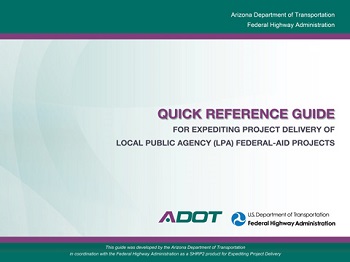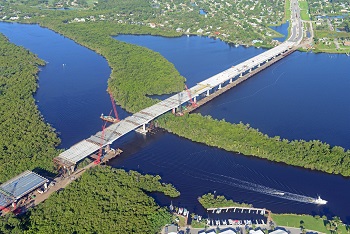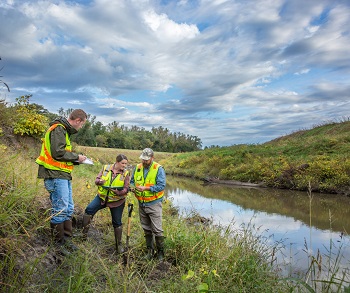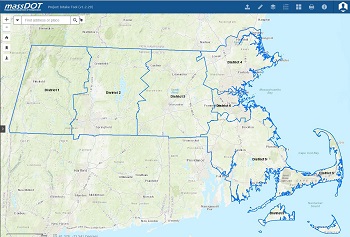Printer-friendly PDF version (5.2 MB)
Expediting Project Delivery (C19) Brochure
Tested, Proven Strategies for Planning and Environmental Reviews

Abstract
This brochure highlights 24 strategies to address the 16 common constraints to transportation project development. Ten states and 12 transportation agencies have used the approach. Key resources include Expediting Project Delivery Self Assessment Workbook and the Expediting Project Delivery website.
Expediting Project Delivery (C19) offers 24 proven and effective strategies that focus specifically on the planning, National Environmental Policy Act (NEPA), and permitting phases of project development and delivery. Developed through the second Strategic Highway Research Program (SHRP2), the recommended strategies address 16 common constraints that transportation agencies encounter when trying to meet project schedules, reduce risk, and build strong collaborative processes.
These strategies save time, reduce the need for rework, reduce the risk of unanticipated permitting and mitigation costs, and provide a framework for resolving disputes.
Agencies may choose to adopt the entire suite or individual strategies based on an assessment of their needs. The strategies are organized into six objectives:
- Streamline decision making
- Improve resource agency involvement and collaboration
- Improve public involvement and support
- Demonstrate real commitment to the project
- Improve internal communication and coordination
- Integrate across all phases of project delivery
Common Constraints to Transportation Project Delivery
| Constraint 1: |
Avoiding policy decisions through continual analysis |
| Constraint 2: |
Conflicting resource values |
| Constraint 3: |
Difficulty agreeing on impacts and mitigation |
| Constraint 4: |
Inability to maintain agreement |
| Constraint 5: |
Ineffective internal communication |
| Constraint 6: |
Inefficient Section 106 consultation with State Historic Preservation Officer |
| Constraint 7: |
Inordinate focus on single issue |
| Constraint 8: |
Insufficient public engagement or support |
| Constraint 9: |
Issues arising late cause project change |
| Constraint 10: |
Lack of dedicated staff |
| Constraint 11: |
Lengthy review and revision cycles |
| Constraint 12: |
Negative or critical coverage from the media |
| Constraint 13: |
Relocation process delays construction |
| Constraint 14: |
Slow decision making |
| Constraint 15: |
Stakeholder controversy and opposition |
| Constraint 16: |
Unusually large scale of and/or complex project or program |
Strategies for Addressing Constraints and Expediting Project Delivery
| Strategy 1: |
Change-control practices |
| Strategy 2: |
Consolidated decision council |
| Strategy 3: |
Context-sensitive design and solutions |
| Strategy 4: |
Coordinated and responsive agency involvement |
| Strategy 5: |
Dispute-resolution process |
| Strategy 6: |
DOT-funded resource agency liaisons |
| Strategy 7: |
Early commitment of construction funding |
| Strategy 8: |
Expedited internal review and decision making |
| Strategy 9: |
Facilitation to align expectations up front |
| Strategy 10: |
Highly responsive public engagement |
| Strategy 11: |
Incentive payments to expedite relocations |
| Strategy 12: |
Media relations manager |
| Strategy 13: |
Performance standards |
| Strategy 14: |
Planning and environmental linkages |
| Strategy 15: |
Planning-level environmental screening criteria |
| Strategy 16: |
Programmatic agreement for Section 106 |
| Strategy 17: |
Programmatic or batched permitting |
| Strategy 18: |
Real-time collaborative interagency reviews |
| Strategy 19: |
Regional environmental analysis framework |
| Strategy 20: |
Risk management |
| Strategy 21: |
Strategic oversight and readiness assessment |
| Strategy 22: |
Team co-location |
| Strategy 23: |
Tiered NEPA process |
| Strategy 24: |
Up-front environmental commitments |
Expediting Project Delivery Strategies Deliver Results
The strategies achieve results by improving internal and external coordination through the project development and environmental review processes.
Key benefits to transportation agencies:
- Leads to fewer delays and more predictable project delivery timeframes
- Saves staff time and money through more effective practices
- Improves public trust through on-time and on-budget project delivery
How do you know which strategies to apply?
- Develop an Action Plan for your agency by utilizing the Expediting Project Delivery Self-Assessment Workbook (see last page for reference).
- Conduct an assessment of your delivery program to identify routine delivery challenges (constraints).
- Evaluate the relationship of the constraints. Are they specific to a step in project development or an activity?
- Based on the constraint type, determine the associated Expediting Project Delivery strategies by using the adjacent table.
- Consider selecting the strategies that address your immediate constraint, but also benefit other aspects of your program.
Practical Tips for Applying These Strategies
- Develop multidisciplinary teams to break up the sequential “silo” approach.
- Cross-train key staffers in planning and environmental areas.
- Consider using collaboration platforms and software that allow for electronic document sharing.
- Create a clear and consistent public engagement and outreach plan; use project-dedicated and seasoned communications staff to interact with the media.
The Hallmarks of Expediting Project Delivery
- Early is always better.
- Communication among all parties is paramount.
- Clear decision paths and commitments lead to less risk and smoother resolutions.
- Adopting these strategies results in better projects, completed more quickly and efficiently, and with recognized benefits and outcomes.
| |
Constraint |
| Strategy |
1.
Avoiding policy decisions through continual analysis |
2.
Conflicting resource values |
3.
Difficulty agreeing on impacts and mitigation |
4.
Inability to maintain agreement |
5.
Ineffective internal communication |
6.
Inefficient Section 106 consultation with State Historic Preservation Officer |
7.
Inordinate focus on single issue |
8.
Insufficient public engagement or support |
| 1. Change-control practices |
|
|
|
|
|
|
|
|
| 2. Consolidated decision council |
◼ |
|
|
◼ |
◼ |
|
◼ |
|
| 3. Context-sensitive design and solutions |
|
◼ |
|
|
|
|
|
|
| 4. Coordinated and responsive agency involvement |
|
|
|
|
|
|
|
|
| 5. Dispute-resolution process |
◼ |
◼ |
◼ |
◼ |
|
|
◼ |
|
| 6. DOT-funded resource agency liaisons |
|
|
|
◼ |
|
|
|
|
| 7. Early commitment of construction funding |
|
|
|
◼ |
|
|
|
|
| 8. Expedited internal review and decision making |
◼ |
|
|
|
◼ |
|
|
|
| 9. Facilitation to align expectations up front |
◼ |
|
◼ |
◼ |
|
|
◼ |
|
| 10. Highly responsive public engagement |
|
|
|
◼ |
|
|
|
◼ |
| 11. Incentive payments to expedite relocations |
|
|
|
|
|
|
|
|
| 12. Media relations manager |
|
|
|
◼ |
|
|
|
◼ |
| 13. Performance standards |
|
◼ |
|
|
|
|
|
|
| 14. Planning and environmental linkages |
|
◼ |
◼ |
◼ |
|
◼ |
|
|
| 15. Planning-level environmental screening criteria |
◼ |
◼ |
◼ |
◼ |
|
◼ |
◼ |
|
| 16. Programmatic Agreement for Section 106 |
|
|
|
|
|
◼ |
|
|
| 17. Programmatic or batched permitting |
◼ |
|
◼ |
◼ |
|
|
|
|
| 18. Real-time collaborative interagency reviews |
|
|
|
|
◼ |
|
◼ |
|
| 19. Regional environmental analysis framework |
◼ |
|
◼ |
|
|
|
◼ |
|
| 20. Risk management |
◼ |
◼ |
◼ |
◼ |
◼ |
◼ |
◼ |
◼ |
| 21. Strategic oversight and readiness assessment |
|
|
|
◼ |
◼ |
|
|
|
| 22. Team co-location |
|
|
|
|
◼ |
|
|
|
| 23. Tiered NEPA approach |
|
|
|
◼ |
|
|
|
|
| 24. Up-front environmental commitments |
◼ |
◼ |
◼ |
|
|
|
|
|
| |
Constraint |
| Strategy |
9.
Issues arising late cause project change |
10.
Lack of dedicated staff |
11.
Lengthy review and revision cycles |
12.
Negative or critical media coverage |
13.
Relocation process delays construction |
14.
Slow decision making |
15.
Stakeholder controversy and opposition |
16.
Unusually large and/or complex project or program |
| 1. Change-control practices |
◼ |
|
|
|
|
|
|
|
| 2. Consolidated decision council |
|
|
|
|
|
◼ |
|
|
| 3. Context-sensitive design and solutions |
◼ |
|
|
|
|
|
◼ |
|
| 4. Coordinated and responsive agency involvement |
|
|
◼ |
|
|
◼ |
|
|
| 5. Dispute-resolution process |
◼ |
|
|
|
|
|
|
|
| 6. DOT-funded resource agency liaisons |
|
◼ |
|
|
|
◼ |
|
|
| 7. Early commitment of construction funding |
|
◼ |
|
|
|
◼ |
|
◼ |
| 8. Expedited internal review and decision making |
|
◼ |
|
|
|
|
|
◼ |
| 9. Facilitation to align expectations up front |
◼ |
|
|
|
|
|
◼ |
|
| 10. Highly responsive public engagement |
◼ |
|
|
◼ |
◼ |
|
◼ |
|
| 11. Incentive payments to expedite relocations |
|
|
|
|
◼ |
|
|
|
| 12. Media relations manager |
|
|
|
◼ |
◼ |
|
◼ |
|
| 13. Performance standards |
|
|
|
|
|
|
|
◼ |
| 14. Planning and environmental linkages |
◼ |
|
◼ |
|
|
◼ |
|
|
| 15. Planning-level environmental screening criteria |
◼ |
|
◼ |
|
|
|
|
|
| 16. Programmatic Agreement for Section 106 |
|
|
|
|
|
|
|
|
| 17. Programmatic or batched permitting |
|
◼ |
◼ |
|
|
|
|
◼ |
| 18. Real-time collaborative interagency reviews |
◼ |
|
◼ |
|
|
◼ |
|
|
| 19. Regional environmental analysis framework |
|
|
|
|
|
|
◼ |
◼ |
| 20. Risk management |
◼ |
◼ |
◼ |
◼ |
◼ |
◼ |
◼ |
◼ |
| 21. Strategic oversight and readiness assessment |
|
◼ |
|
|
|
◼ |
|
◼ |
| 22. Team co-location |
|
|
◼ |
|
|
◼ |
|
◼ |
| 23. Tiered NEPA approach |
◼ |
|
|
|
|
|
|
|
| 24. Up-front environmental commitments |
|
|
|
|
|
|
|
◼ |

To improve communications within its complex Local Public Agency Program, the Arizona Department of Transportation used a SHRP2 C19 award to create a Quick Reference Guide for Local Public Agency projects. The guide emphasizes that all project team members have a sound understanding of the “basics” and that continuous communication happen throughout project development, resulting in a more efficient environmental review and expedited project delivery.

Aligning resource priorities with transportation projects early in the planning phase reduces costly delays experienced during project delivery. Early engagement between the California Department of Transportation and resource and regulatory agencies helps identify opportunities for incorporating environmental enhancements and species recovery strategies into future transportation projects, thus meeting both transportation and ecological objectives through a more integrated process. This expedites project delivery by reducing delays that affect project cost, scope, and schedule, while improving relationships with resource and regulatory agencies.
Strategies for Expediting Project Delivery
Strategy 1: Change-Control Practices
By establishing change-control practices, agencies can minimize the frequency and severity of changes to project design following preliminary design and environmental documentation.
Strategy 2: Consolidated Decision Council
A consolidated decision council can create a clear organization, structure, and process for efficient decision making. Councils identify the ability and scope of decision making explicitly and allow for issues or questions to be on the agenda, considered, and decided on effectively and efficiently.
Strategy 3: Context-Sensitive Design and Solutions
Using a collaborative, interdisciplinary approach, stakeholders can design a transportation facility that fits its physical setting and preserves local resources while maintaining safety and mobility. Resource agencies, the public, and stakeholder organizations are engaged in the planning and design of the project.
Strategy 4: Coordinated and Responsive Agency Involvement
Establishing clear and direct communications with resource agencies early in the development of a project promotes a culture of collaboration and understanding which leads to more effective interagency working relationships.
Strategy 5: Dispute-Resolution Process
By creating a clear dispute-resolution process agreed to by all parties, agencies can avoid an impasse that can halt or delay a process and identify the path to a workable solution by elevating and resolving any impasse at the staff level.
Strategy 6: Department of Transportation-Funded Resource Agency Liaisons
By funding positions to perform environmental analysis at resource agencies and nongovernmental organizations, a state DOT can expedite project reviews.
Strategy 7: Early Commitment of Construction Funding
Securing a commitment of construction funding early in the planning or NEPA phase of project development helps gain the attention, will, and other commitments necessary to expedite decisions and delivery.

The NEPA phase for two FDOT bridge projects in Martin County, Florida, was accelerated by applying C19 strategies.

Strategy 8: Expedited Internal Review and Decision Making
By implementing a process for timely internal reviews and getting formal commitments from each agency, office, section, or bureau to make decisions efficiently and quickly will help to establish this strategy as an accepted routine.
Strategy 9: Facilitation to Align Expectations Up Front
On projects with diverse and multiple agencies and major stakeholder groups, early facilitated discussions in planning or scoping can identify specific agency or stakeholder interests and align all parties’ expectations at the beginning of the project.

The Florida Department of Transportation (FDOT) used an accelerated schedule to deliver reconstructed beach improvements after Hurricane Sandy devastated the area.
Strategy 10: Highly Responsive Public Engagement
Identifying specific and direct ways in which the public can contribute to decisions on public projects helps builds support, reduces potential opposition and delays, and enables stakeholders to more easily see the role they play in the outcome.
Strategy 11: Incentive Payments to Expedite Relocations
Awarding payments beyond the traditional relocation costs to tenants, property owners, and business owners to relocate within certain timeframes can expedite the relocation process, reducing potential delays to project construction.

The Nebraska Department of Transportation expedites project delivery through improved Clean Water Act, Section 404 permit applications, submitted to the US Army Corps of Engineers, Nebraska Regulatory Office.
Strategy 12: Media Relations Manager
Using a project-level staff person with career experience in journalism and social media to tell the project “story” and work directly with the media can help reduce misrepresentations and misinformation.
Strategy 13: Performance Standards
Including a specific measurable and outcome-based performance standards in a permit or approval enables all stakeholders to understand the value and benefit of the finished improvements.
Strategy 14: Planning and Environmental Linkages
By using the data, analysis, and decision making from prior planning studies, the NEPA process can be expedited, reducing the time and effort necessary to develop and evaluate alternatives and produce the required environmental documentation.
Strategy 15: Planning-Level Environmental Screening Criteria
Early consultation on resources and mitigation provides an opportunity to identify criteria and develop tools and understandings for project delivery. By developing statewide and/or regional data, transportation agencies can quickly evaluate and compare proposed projects and programs, identify potential areas of environmental concern, and make better-informed decisions about how to develop future projects.
Strategy 16: Programmatic Agreement for Section 106
Using a programmatic agreement, federal lead agencies, the State Historic Preservation Office (SHPO), and the Advisory Council on Historic Preservation can delegate some authority to a state DOT to conduct Section 106 reviews on behalf of FHWA, while identifying certain classes of projects or activities that will not need to undergo the traditional individual consultation process with SHPO.
Strategy 17: Programmatic or Batched Permitting
A single permit that covers multiple or separate actions can substantially expedite permitting and, therefore, project delivery. There are two basic approaches—batched or programmatic. A batched permit or approval covers specific actions identified in advance of the permit. A programmatic permit covers a collection of future actions that may or may not be identified in advance of the permit.

MaPIT software gives the Massachusetts Department of Transportation and other state/municipal proponents the ability to plan and initiate projects using the latest GIS technology.
Strategy 18: Real-Time Collaborative Interagency Reviews
Conducting collaborative and concurrent reviews of environmental documentation, possibly in sections, state DOTs, the FHWA, and resource agencies can reduce the time needed to conduct these reviews and the overall schedule for completing the environmental document.
Strategy 19: Regional Environmental Analysis Framework
By establishing a standardized approach for evaluating impacts to resources types, impact analyses and mitigation agreements can be streamlined. And, a uniform approach for evaluating cumulative effects can be established.
Strategy 20: Risk Management
Risk management is the practice of actively dealing with project risk, including planning for risk, assessing risk, developing risk-response strategies, and monitoring risk throughout the project life cycle. It is more effective when started near the beginning of any process.
Strategy 21: Strategic Oversight and Readiness Assessment
For multi-agency projects, creating a protocol for communication, specifying roles and responsibilities, and setting a review timeline early in the project helps the agencies plan their staffing and funding commitments. This preparation allows staff to accept project assignments when their participation is needed.
Strategy 22: Team Co-Location
Co-locating project teams allows for faster communication, reviews, and decision making while offering opportunities for spontaneous working sessions or meetings that can expedite a project.
The “Sand Hill Bridge” over the Middlebury River was one of five bridge projects the Vermont Department of Transportation (VTrans) used a SHRP2 C19 research award to focus on improving internal communication and coordination and improving public involvement and support. All five bridge replacement projects required significant coordination of the bridge closure periods and alternating detour routes, and were replaced in record time using accelerated bridge construction methods and short-term road closures. The “Fast Five” showcased the opportunities for expediting project delivery.

VTrans used project factsheets, preclosure public information meetings, a dedicated website, and weekly email updates to keep residents informed. A post-construction survey on the ABC approach to replacing bridge structures, communication with the public, and satisfaction with the new bridges showed that 83 percent of the 41 respondents were very satisfied with accelerated bridge construction and 74 percent were very satisfied with the information that they received about the projects during construction.
Strategy 23: Tiered NEPA Process
Using this strategy, agencies can perform planning studies under NEPA via a Tier 1 Environmental Assessment or Environmental Impact Statement. The first-tier study looks at a large problem programmatically, with project-level studies and analysis in the second tier.
Strategy 24: Up-Front Environmental Commitments
When a DOT makes a commitment to invest in environmental avoidance, minimization and/or mitigation earlier in the planning process, permits and agreements can be approved without a lengthy process of analysis and debate.
Who’s using these strategies?
Through the FHWA/AASHTO Implementation Assistance Program, 12 transportation agencies in 10 states are implementing Expediting Project Delivery strategies.
Lead Adopter Incentive
Technical and/or financial support is made available for early adopters to offset implementation costs and mitigate risks.
User Incentive
Technical and financial assistance used to conduct internal assessments, build capacity, implement system process changes, organize peer exchanges, and offset other implementation costs.
Agencies Expediting Project Delivery
- ADOT created a Quick Reference Guide for Local Public Agencies to improve project delivery.
- ARDOT developed a project initiation form to help with risk management.
- AMBAG created Transfi, a group dedicated to sharing transportation finance and grant opportunities.
- Caltrans created an Action Plan that focused on recommendations for highway stream crossing structures.
- FDOT District 4 developed process refinements and implemented streamlining measures in the Project Development & Environment process.
- ITD is purchasing software to complete the automation of the Highway Safety Corridor Analysis.
- MAG worked with regional partners to share geospatial data in a Story Map for the region.
- MassDOT developed a web-based application that modernizes the early stages of the MassDOT project development process, called the MassDOT Project Intake Tool (MaPIT).
- NDOT coordinated with resource and regulatory agencies to discuss programmatic 404 permitting, which resulted in process improvements to the project delivery process.
- SCDOT developed a proposed Process Map for the Project Management unit to improve workload to expedite project delivery.
- SDDOT identified actions to improve public engagement and increase schedule accountability and consider internal resource allocation through an Assessment Workshop.
- VTrans developed process improvements to make the Accelerated Bridge Program (ABP) function better.
Resources
For more information online, go to FHWA’s SHRP2 C19 web page at https://www.environment.fhwa.dot.gov/env_initiatives/SHRP2.aspx.
To determine which strategies would benefit your program, review the Expediting Project Delivery Self-Assessment Workbook (available online at https://www.environment.fhwa.dot.gov/env_initiatives/shrp2/docs/Expediting_Project_Delivery_Self_Assessment_Workbook.pdf) to learn how to conduct your own assessment.
Contacts

